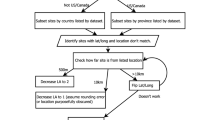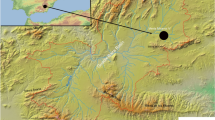Abstract
Advanced geoscience techniques are essential to contextualize fossils, artefacts and other archaeologically important material accurately and effectively. Their appropriate use will increase confidence in new interpretations of the fossil and archaeological record, providing important information about the life and depositional history of these materials and so should form an integral component of all human evolutionary studies. Many of the most remarkable recent finds that have transformed the field of human evolution are small and scarce, ranging in size from teeth to strands of DNA, recovered from complex sedimentary environments. Nevertheless, if properly analysed, they hold immense potential to rewrite what we know about the evolution of our species and our closest hominin ancestors.
This is a preview of subscription content, access via your institution
Access options
Access Nature and 54 other Nature Portfolio journals
Get Nature+, our best-value online-access subscription
$29.99 / 30 days
cancel any time
Subscribe to this journal
Receive 12 digital issues and online access to articles
$119.00 per year
only $9.92 per issue
Buy this article
- Purchase on Springer Link
- Instant access to full article PDF
Prices may be subject to local taxes which are calculated during checkout


Similar content being viewed by others
References
Hendy, J. Ancient protein analysis in archaeology. Sci. Adv. 7, eabb9314 (2021).
Orlando, L. et al. Ancient DNA analysis. Nat. Rev. Methods Primers 1, 14 (2021).
Martin, J. M. et al. Drimolen cranium DNH 155 documents microevolution in an early hominin species. Nat. Ecol. Evol. 5, 38–45 (2021).
Baab, K. L., McNulty, K. P. & Rohlf, F. J. The shape of human evolution: a geometric morphometrics perspective. Evol. Anthropol. 21, 151–165 (2012).
Green, R. E. et al. A draft sequence of the Neanderthal genome. Science 328, 710–722 (2010).
Meyer, M. et al. Nuclear DNA sequences from the Middle Pleistocene Sima de los Huesos hominins. Nature 531, 504–507 (2016).
Reich, D. et al. Genetic history of an archaic hominin group from Denisova Cave in Siberia. Nature 468, 1053–1060 (2010).
Meyer, M. et al. A high-coverage genome sequence from an archaic Denisovan individual. Science 338, 222–226 (2012).
Slon, V. et al. The genome of the offspring of a Neanderthal mother and a Denisovan father. Nature 561, 113–116 (2018).
Patterson, D. B. et al. Comparative isotopic evidence from East Turkana supports a dietary shift within the genus Homo. Nat. Ecol. Evol. 3, 1048–1056 (2019).
Joannes-Boyau, R. et al. Elemental signatures of Australopithecus africanus teeth reveal seasonal dietary stress. Nature 572, 112–115 (2019).
Lugli, F. et al. Strontium and stable isotope evidence of human mobility strategies across the Last Glacial Maximum in southern Italy. Nat. Ecol. Evol. 3, 905–911 (2019).
Goldberg, P., Holliday, V. T. & Ferring, C. R. (eds) Earth Sciences and Archaeology (Springer Science & Business Media, 2013).
Renfrew, C. in Geoarchaeology: Earth Science and the Past (eds Davidson, D. A. & Shackley, M.L.) 1–5 (Westview Press, 1976).
Butzer, K. W. Archaeology as Human Ecology: Method and Theory for a Contextual Approach (Cambridge Univ. Press, 1982).
Morley, M. W. The geoarchaeology of hominin dispersals to and from tropical Southeast Asia: a review and prognosis. J. Archaeol. Sci. 77, 78–93 (2017).
Goldberg, P., Macphail, R. I., Carey, C. & Zhuang, Y. Practical and Theoretical Geoarchaeology (John Wiley, 2022).
Zerboni, A. Micromorphology reveals in situ Mesolithic living floors and archaeological features in multiphase sites in central Sudan. Geoarchaeology 26, 365–391 (2011).
Hublin, J. J. et al. Initial upper Palaeolithic Homo sapiens from Bacho Kiro Cave, Bulgaria. Nature 581, 299–302 (2020).
Morley, M. W. et al. Hominin and animal activities in the microstratigraphic record from Denisova Cave (Altai Mountains, Russia). Sci. Rep. 9, 13785 (2019).
Herries, A. I. et al. Contemporaneity of Australopithecus, Paranthropus and early Homo erectus in South Africa. Science 368, eaaw7293 (2020).
Weiner, S. Microarchaeology: Beyond the Visible Archaeological Record (Cambridge Univ. Press 2010).
Mentzer, S. M. Microarchaeological approaches to the identification and interpretation of combustion features in prehistoric archaeological sites. J. Archaeol. Method Theory 21, 616–668 (2014).
Berger Lee, R. et al. Evidence for deliberate burial of the dead by Homo naledi. eLife 12, RP89106 (2023).
Goldberg, P. & Berna, F. Micromorphology and context. Quat. Int. 214, 56–62 (2010).
Schiffer, M. B. Archaeological context and systemic context. Am. Antiq. 37, 156–165 (1972).
IPad Pro is Revolutionizing How Archaeologists Preserve the Ancient History of Pompeii. Apple Newsroom https://www.apple.com/newsroom/2022/09/ipad-pro-is-revolutionizing-how-archaeologists-preserve-the-history-of-pompeii/ (27 September 2022).
Braun, D. R. et al. Earliest known Oldowan artifacts at >2.58 Ma from Ledi-Geraru, Ethiopia, highlight early technological diversity. Proc. Natl Acad. Sci. USA 116, 11712–11717 (2019).
Maloney, T. R. et al. Surgical amputation of a limb 31,000 years ago in Borneo. Nature 609, 547–551 (2022).
Maloney, T. R. et al. A late Pleistocene to Holocene archaeological record from East Kalimantan, Borneo. Quat. Sci. Rev. 277, 107313 (2022).
Slon, V. et al. Neandertal and Denisovan DNA from Pleistocene sediments. Science 356, 605–608 (2017).
Slon, V. et al. Extended longevity of DNA preservation in Levantine Paleolithic sediments, Sefunim Cave, Israel. Sci. Rep. 12, 14528 (2022).
Zhang, D. et al. Denisovan DNA in late Pleistocene sediments from Baishiya Karst Cave on the Tibetan Plateau. Science 370, 584–587 (2020).
Welker, F. et al. The dental proteome of Homo antecessor. Nature 580, 235–238 (2020).
Massilani, D. et al. Microstratigraphic preservation of ancient faunal and hominin DNA in Pleistocene cave sediments. Proc. Natl Acad. Sci. USA 119, e2113666118 (2022).
Copeland, S. R. et al. Strontium isotope evidence for landscape use by early hominins. Nature 474, 76–78 (2011).
Stewart, B. A. et al. Ostrich eggshell bead strontium isotopes reveal persistent macroscale social networking across late Quaternary southern Africa. Proc. Natl Acad. Sci. USA 117, 6453–6462 (2020).
Ji, Q., Wu, W., Ji, Y., Li, Q. & Ni, X. Late Middle Pleistocene Harbin cranium represents a new Homo species. Innovation 2, 3 (2021).
Duller, G. A. Dating methods: the role of geochronology in studies of human evolution and migration in southeast Asia and Australasia. Prog. Phys. Geogr. 25, 267–276 (2001).
Dennell, R. W. in Southern Asia, Australia and the Search for Human Origins (eds Dennell, R. & Porr, M.) 8–20 (Cambridge Univ. Press, 2014)
Slimak, L. et al. Modern human incursion into Neanderthal territories 54,000 years ago at Mandrin, France. Sci. Adv. 8, eabj9496 (2022).
Duller, G. A. T. Distinguishing quartz and feldspar in single grain luminescence measurements. Radiat. Meas. 37, 161–165 (2003).
Greilich, S., Glasmacher, U. A. & Wagner, G. A. Spatially resolved detection of luminescence: a unique tool for archaeochronometry. Naturwissenschaften 89, 371–375 (2002).
Fu, X. et al. Beta dose heterogeneity in sediment samples measured using a Timepix pixelated detector and its implications for optical dating of individual mineral grains. Quat. Geochronol. 68, 101254 (2022).
Morley, M. W. et al. Initial micromorphological results from Liang Bua, Flores (Indonesia): site formation processes and hominin activities at the type locality of Homo floresiensis. J. Archaeol. Sci. 77, 125–142 (2017).
Brown, S. et al. Identification of a new hominin bone from Denisova Cave, Siberia using collagen fingerprinting and mitochondrial DNA analysis. Sci. Rep. 6, 23559 (2016).
Acknowledgements
M.W.M., I.M., A.M.K.-M., A.I.R.H., R.J.-B. and K.W. receive funding support from the Australian Research Council (ARC), through Future Fellowships FT180100309 (M.W.M.) and FT220100184 (I.M.), Linkage Project LP210300105 (A.M.K.-M.), and Discovery Projects DP170100056 (A.I.R.H.), DP220100195 (R.J.-B.) and DP170101597 (K.W.). V.C.H. receives funding support through a Flinders International Postgraduate Research Scholarship. A.Z. receives funding support from the SPHeritage Project (MUR Grant FISR2019_00040).
Author information
Authors and Affiliations
Corresponding author
Ethics declarations
Competing interests
The authors declare no competing interests.
Peer review
Peer review information
Nature Ecology & Evolution thanks the anonymous reviewers for their contribution to the peer review of this work.
Supplementary information
Rights and permissions
Springer Nature or its licensor (e.g. a society or other partner) holds exclusive rights to this article under a publishing agreement with the author(s) or other rightsholder(s); author self-archiving of the accepted manuscript version of this article is solely governed by the terms of such publishing agreement and applicable law.
About this article
Cite this article
Morley, M.W., Moffat, I., Kotarba-Morley, A.M. et al. Why the geosciences are becoming increasingly vital to the interpretation of the human evolutionary record. Nat Ecol Evol 7, 1971–1977 (2023). https://doi.org/10.1038/s41559-023-02215-5
Received:
Accepted:
Published:
Issue Date:
DOI: https://doi.org/10.1038/s41559-023-02215-5



